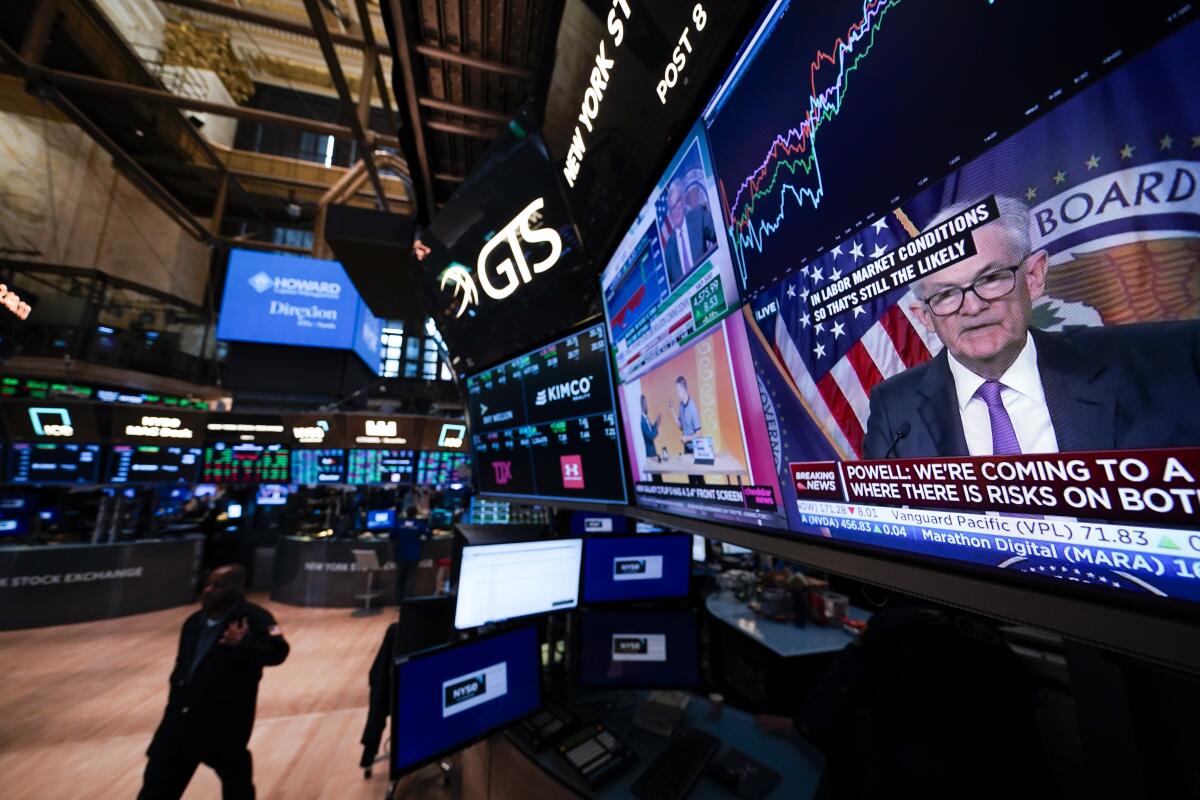Federal Reserve signals that interest rate cuts aren’t imminent, leaving them unchanged for now

Interest rate cuts are coming. Just not yet.
The Federal Reserve delivered that message Wednesday, first in a policy statement and then in a news conference at which Chair Jerome H. Powell reinforced it.
The Fed did signal that it’s nearing a long-awaited shift toward cutting interest rates, evidence that officials are confident that they’re close to fully taming inflation. No longer does its policy statement say it’s still considering further rate hikes.
Yet the officials made clear that the first rate cut is likely months away. Their statement cautioned that they don’t think it would be time to cut rates “until it has gained greater confidence that inflation is moving sustainably” to their 2% target.
Investors and some economists had been holding out the possibility that the Fed might cut rates as early as its next meeting in March. That now appears to be off the table.
“I don’t think it’s likely that the committee will reach a level of confidence by the time of the March meeting” to start cutting rates, Powell said at his news conference.
The Fed kept its key rate unchanged at about 5.4%, a 22-year high. But the overall changes to its statement — compared with its last meeting in December — show that it’s moved toward considering rate reductions while still maintaining flexibility.
In December, the officials had indicated that they expected to carry out three quarter-point rate cuts in 2024. Yet they have said little about when those cuts might begin, and senior officials have stressed that the Fed will proceed cautiously.
The central bank’s message Wednesday — that it’s edging closer to cutting rates but not planning to do so anytime soon — disappointed traders on Wall Street. Losses in the stock market accelerated after Powell’s news conference began.
The change in the Fed’s stance Wednesday comes as the economy is showing surprising durability after a series of 11 rate hikes helped drastically slow inflation, which hit a four-decade high 18 months ago. Over the last six months, prices have risen at an annual rate of just below 2%, consistent with the Fed’s target level, according to its preferred inflation gauge. And growth remains healthy. In the final three months of last year, the economy expanded at a 3.3% annual rate, the government said last week.
After an extended period of gloom, Americans are starting to feel better about inflation and the economy — a trend that could sustain consumer spending, fuel economic growth and potentially affect President Joe Biden’s political fortunes
The Fed is assessing inflation and the economy at a time when the intensifying presidential campaign is pivoting in no small part on voters’ perceptions of President Biden’s economic stewardship. Republicans in Congress have attacked Biden over the high inflation that gripped the nation beginning in 2021 as the economy emerged from recession. But the latest economic data — including steady consumer spending, solid job growth and the slowdown in inflation — has been bolstering consumer confidence.
At his news conference, Powell said the Fed welcomes signs of economic strength. But he said the policymakers are seeking further evidence of a sustained slowdown in inflation.
“We want to see strong growth and a strong labor market,” the Fed chair said. “We’re looking for inflation to come down, as it has been coming down for the last six months.”
Most economists have said they expect the Fed to start cutting its benchmark rate in May or June. Rate cuts would eventually lead to lower borrowing costs for America’s consumers and businesses, including for mortgages, auto loans and credit cards.
A year ago, many analysts were predicting that widespread layoffs and sharply higher unemployment would be needed to cool the economy and curb inflation. Yet job growth has been steady. The unemployment rate, at 3.7%, isn’t far above a half-century low.
Labor costs are easing too. On Wednesday, the government reported that pay and benefits for America’s workers, which accelerated in 2022, grew in the final three months of 2023 at the slowest pace in 2 1/2 years.
The Fed appears to be on the verge of achieving a rare “soft landing,” in which it manages to conquer high inflation without causing a recession. Should the pace of economic growth strengthen, though, it could complicate the challenge for the Fed. A much faster expansion, especially one fueled by rate cuts, could potentially reignite inflation.
An uptick in nationwide inflation could have bigger consequences for Californians who are already paying higher prices for basic goods and services, including housing and energy.
On the other hand, any evidence that the economy is slowing appreciably probably would accelerate the Fed’s timetable for rate cuts. And indeed, some cracks in the job market have begun to emerge and, if they worsen, could spur the Fed to cut rates quickly.
“If we saw an unexpected weakening in the labor market, that would certainly weigh on cutting sooner,” Powell said at his news conference. “If we saw inflation being stickier or higher, it would argue for moving later.”
Asked whether he thought the Fed has already achieved a soft landing, Powell suggested it would be premature to say so.
“We have a ways to go,” he said. “Core inflation is still well above target on a 12-month basis. Certainly, I’m encouraged and we’re encouraged by the progress, but we’re not declaring victory at this point. We think we have a ways to go.”
For several months, for example, most of the job growth has occurred in just a few sectors — healthcare, government and hotels, restaurants and entertainment. Any weakening in those areas of the economy could threaten hiring and the overall expansion.
And a report Tuesday showed that the number of workers who quit in December reached its lowest level in three years. That suggested that fewer Americans are being recruited for new, higher-paying jobs or are willing to search for and take new positions. Although resignations remain at a level consistent with a solid job market, they have fallen about one-third from their peak in mid-2022.
Still, the U.S. economy is outdoing its counterparts overseas. During the October-December quarter, the 20 countries that share the euro currency barely avoided a recession, posting essentially no growth. Still, as in the United States, unemployment is very low in the euro area, and inflation has slowed to a 2.9% annual rate. Although the European Central Bank could cut rates as soon as April, many economists think that might not happen until June.
More to Read
Inside the business of entertainment
The Wide Shot brings you news, analysis and insights on everything from streaming wars to production — and what it all means for the future.
You may occasionally receive promotional content from the Los Angeles Times.












